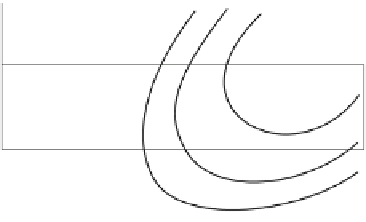Environmental Engineering Reference
In-Depth Information
178
20
177
179
181
15
188
SFC
-1
[g*kWh ]
191
196
201
207
213
219
10
5
400
500
600
-1
number of revolutions [1*min ]
specific heating value of fuel 42.7*10 J*kg
6
-1
Fig. 11.1
SFC of a medium speed marine diesel engine in fuel consumption diagram
• Reducing the heat losses of the cylinder walls by optimizing the thermal insu-
lation of all heat parts, particularly near the cylinders;
• Introducing variable swirl with the injection of the fuel;
• Using variable intake air flow;
• Introducing a variable compression ratio using specific high dynamic pressure
and temperature sensor and actuator technology;
• Using SCR catalyst and particle filters in the exhaust gas after treatment system
additionally to recent silencer technology and occasionally in addition to the
exhaust gas boiler technology; and
• Applying gas concentration and particle sensors to monitor the catalyst and the
particle filter [
3
].
All parts of the engine, the turbocharger, the compressor and the exhaust gas
after treatment system must be optimized to reduce fuel consumption and emis-
sions. The use of electric turbochargers is possible, but electric motors are great
and have disadvantageous high inertia when starting.
The SFC firstly depends on the number of revolutions and the exhaust gas
pressure. The piston-stroke to bore ratio, the size and the form of the valve cross
section and the valve timing additionally influences the SFC [
4
].
The SFC can be estimated, depending on the number of revolutions and the
Break Mean Effective Pressure (BMEP), with fuel consumption diagrams drawn
on paper or on computer (see Fig.
11.1
)[
5
].
Changes in the SFC can be exactly measured with analyzing CO
2,
unburned
hydrocarbons and carbon monoxide concentrations in the exhaust gas. The pre-
conditions for successful analysis are suitable micro measurement devices appli-
cable in ships, which can analyze the concentration with the required accuracy and
durability [
6
].













Search WWH ::

Custom Search